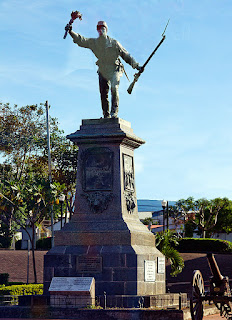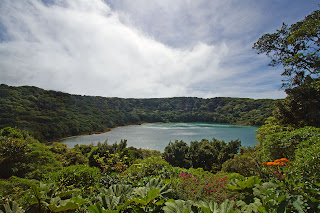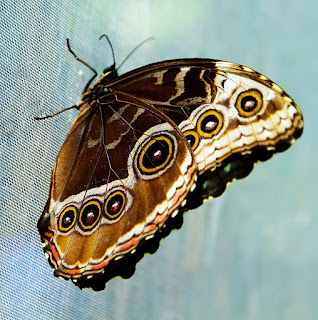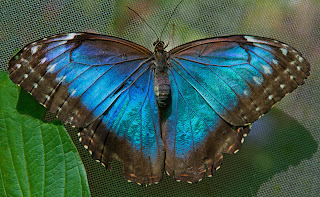On our first full day in Costa Rica, we piled onto our bus and headed out of San Jose to the Poas Volcano National Park. Driving through the streets of San Jose, I managed to grab a few awkward shots as we sped along. The first is Juan Santamaria Park and the statue to honor Juan, a Costa Rican soldier officially recognized
as the national hero of his country for helping repel a Nicaraguan invasion in 1856. A national holiday in Costa Rica,
Juan Santamaría Day, is held every April 11 to commemorate his death. Also, the airport in San Jose is named for him.
 |
| Juan Santamaria Statue | |
|
One of the street corners caught my eye, having what appears to be a community bulletin board and a group of pay phones, not seen around the U.S. anymore. One pay phone is lower than the others to accommodate smaller folks.
At Poas Volcano, we took a short walk up the mountain to the 8800 foot level, where we could look into the caldera 1000 feet below.
Poas is an active volcano with frequent small geyser
and lava eruptions. The last major eruptions at Poas Volcano were from
1952-54. The water in the crater is highly acidic, with a PH of about 1. We were told the crater can be seen only about 30% of the time due to clouds, so we were fortunate to have a clear day.
 |
| Poas Volcano Caldera |
We then took a longer hike up a steeper trail to visit Lake Botos in the crater left from an eruption about 7500 years ago. The hike was through the "cloud forest" that encompasses the entire park.
 |
| Lake Botos |
This area is rich in flora and fauna, with leather leaf fern being so plentiful it is exported to many countries for use in floral arrangements.
 |
| Leather Leaf Fern |
The countryside is dotted with screens that protect the fern crops from harsh sun and soften the rain to prevent erosion. Locals call these "greenhouses".
 |
| Greenhouses | | | |
Our next stop was at Doka Estate coffee plantation, where we had lunch before getting a tour of the plantation's grounds and operation. The grounds are lovely and worth seeing even without seeing the coffee fields and processing.
 |
| Doka Estate |
 |
| Mural in the restaurant. |
 |
| Our tour guide and coffee plants. |
Coffee beans, called "cherries", must be picked by hand since they ripen at different rates. Human judgment is needed to pick only the ripe ones.
 |
| "Cherries" at different growth stages. | | |
|
After peeling the outer hull and grading, the beans (still within a shell) are spread on concrete for drying, which takes several days, depending on climate. To ensure even drying, the beans are turned by hand with a rake every 45 minutes. Eventually, the actual beans are removed and roasted. The roasting time determines the flavor, along with natural factors.
 |
| Drying coffee |
 |
| Raking coffee |
One of the most unusual plants I saw at the plantation is the rainbow bark eucalyptus tree.
Our stay at Doka Estate wrapped up with some time in the butterfly garden, where a variety of butterflies entertained us. The iconic blue morpho was in abundance, but they rarely light, and immediately close their wings when they do light. So, I felt very fortunate when a nice lady from our tour called me to see one resting with wings spread.
 |
| Blue morpho at rest. |
 |
| Blue morpho with wings spread. |
Heading back to San Jose and our hotel, I took more photos from the bus, getting mostly parks and street scenes.
The building that looks like a fort or castle is an important museum, and that is razor wire strung across the scene. First time visitors to Costa Rica will be surprised at the security measures common at homes and businesses. Chain link fencing, window bars and razor wire are universally used for protection against intrusion. Locals explain that securing property is an old custom here, but I suspect there is more to it.
 |
| Museum |
Back at the hotel, I enjoyed a view of a beautiful ravine that runs through town, as well as a nice sunset.





















Great information and photos. Clearly, you listened more closely than I did. Pam
ReplyDeleteI second that!
ReplyDeleteJane
Beautiful photos. I particularly like the blue morpho. Perhaps we can hike some more MN scenery spots when I meet you this summer:) Artfully, Ann
ReplyDeleteThanks, Ann, I'll look forward to that.
ReplyDelete